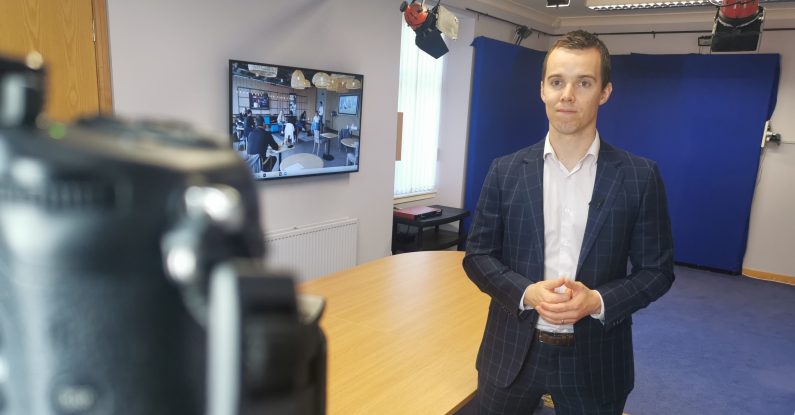
Body language tips for meeting etiquette were clear before March 2020.
If someone turned up to work with their shirt untucked, that was a mark against their name.
If they were late for your first meeting, that may be the last time you met.
Contrast that with the person who was punctual, polite, and listened.
And after the meeting, they did everything they said they would do.
Good meeting etiquette went a long way to building successful relationships.
But what does good meeting etiquette look like in virtual settings?
Here are five questions we should all be asking.
Let’s start with the hardest one.
But also the one that makes the biggest difference.
When you’re talking, lift your eye contact from the screen to the camera lens.
Why? Well, that’s where your audience is. And doing so gives the illusion of a face-to-face meeting.
The trouble is we’re human, and we like to look people in the eye when we’re speaking to them.
So we end up talking to the faces on the screen.
But remember, if you’re ‘looking them in the eye’, they see you speaking to your monitor.
Of course, when it’s their turn to speak, please do look at them as that’s where you’ll pick up body language cues.
Remember, this will take time.
And you’ll need to practice consistently during meetings to get it right.
Some have told us they’ve stuck cartoon eyes next to the camera to remind them.
It took me a full week of training to get used to, so that’s 30+ hours on-screen.
But if you can master it, your audience will be far more engaged – you’re talking directly to them.
There are two presentations going on when we speak to a group of people.
The presentation of your notes to yourself, and then your presentation of that information to the audience.
Is the first helping the second, or hindering it?
In-person, this was everything from cue cards to full-script A4 pages.
But how do you stage-manage that virtually?
You have to think differently.
Firstly, you’re aiming for notes succinct enough that you can make 90% eye contact with the camera.
That means relying on bullet points, mind maps or visual prompts.
Throw your perfectly-written script away.
Unless the stakes are particularly high, sacrifice accuracy of language for virtual engagement.
Secondly, make sure you get the notes in the right place.
A trade secret: I use an A5 hardback booklet and place it just below the camera.
I’m actually unable to see you on screen while I’m talking.
But it means that I can glance down only a couple of inches and see my notes, so I maintain the illusion of 100% eye contact.
If you’re feeling confident, write your notes on a Word document and centralise them, then bring the document up on-screen.
Your audience will still only see you (avoid screen-sharing), but you’ll have the benefit of being able to scroll down your document and keep the relevant notes close to the camera.
Most likely, no.
Why? For the same reason we’re unlikely to grin our way through our driving test.
We’re typically nervous or focused on the task at hand that we forget to smile.
It’s an unnatural task in front of a laptop, so we simply have to work on it.
And it’s one of the most common body language tips we give out.
You can start to change this by drawing a smiley face on top of your notes.
Every time you look down, you’ll see it and smile.
You can also record yourself speaking, before watching it back.
Is that the positive impression you’d like to give?
If the answer is still ‘no’, introduce words likely to prompt a better physiological reaction.
We often tell ourselves internally “I’m very nervous here”.
Unsurprisingly, that’s then mirrored in our demeanour.
So instead, start with: “I’m delighted to be here”.
Or: “I’m so excited to speak with you”.
Cue delight and excitement, cemented in your smile.
Take a look at your setup.
Does it show the full you?
If you’re ‘handsy’, let’s see them.
Push your chair back a foot so we get the wider shot and can see how animated you are.
Avoid sitting on your hands or deliberately keeping them hidden.
It’s unlikely they’ll be a distraction, if that’s what you’re worried about.
People tell us all the time that they simply want to feel they’re in a face-to-face meeting with you, so create that impression.
Let’s have the real you.
We’ve seen all sorts of strangely-lit folk these last couple of years.
Dark silhouettes with their back to a window.
Ghosts with the light a little too close for comfort.
Phantoms of the Opera with one side lit well and the other hidden in darkness.
And some drowning at the bottom of the screen, with only their eyes and foreheads visible.
You can find out much more about the perfect visual setup here.
In the meantime, three pieces of advice:
If you do all of that, you’re giving yourself the best chance of that first impression.
You’re doing everything you can to show you care about the audience by working hard to get it right.
Oh, and remember to tuck your shirt in, and turn up on time.
Andrew McFarlan is Managing Director of Pink Elephant Communications.
You can read more about him here.
Photos in Body language tips blog by Pink Elephant Communications.
Body language tips blog edited by Colin Stone.
12th January 2022 Featured in: Blog, Communication skills training blogs, Presentation skills training blogs, Public speaking training blogs By: Pink Elephant
Some media trainers knock you down…and leave you down. Our media coaches show you how to deal with each knock…and still win through. So you have the presentation skills to perform – with confidence.